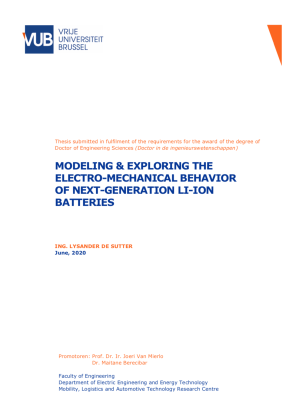
The consumption of fossil fuels, the related increment of greenhouse gas emissions and climate change have become humankind's biggest challenge of the 21th century. Transportation is a natural target for decarbonization initiatives, since it accounts for a third of global greenhouse gas emissions. Vehicle electrification can alleviate pollution if high quality energy storage systems are implemented, such as Li-ion batteries. However, the high acquisition cost, limited range and insufficient charging opportunities remain key challenges for mass electric vehicle adaptation.
To address these challenges, this PhD investigates next-generation Li-ion batteries based on Silicon anodes, which are cheaper and have a tenfold higher energy density compared to current commercial anode materials. Throughout this PhD, it is shown that externally applied pressure on the cell surface is a key battery parameter, which greatly influences its performance. Using an innovative test setup, both the electrical and mechanical behavior of multilayer high capacity Silicon-alloy pouch cells is investigated. Such in-depth analysis on Li-ion cells with a high weight percentage of Si-alloy (55%wt) is unprecedented in literature. The applied external pressure further leads to the development of a dynamic counter-pressure on the constraints during battery operation, which depends on the State of Charge and State of Health. Two modeling methodologies are proposed to estimate cell capacity fade based on pressure measurements and one to predict the pressure evolution of the Si-alloy cells over their entire lifetime. Presumably, this pressure evolution will become a key factor in designing future battery packs containing energy-dense, volume changing electrode materials.
The required shift towards next-generation battery technologies with higher energy- and power densities also necessitates the further improvement in battery management systems, to ensure safe and reliable operation. As such, this PhD develops two accurate battery models, allowing real-time monitoring and capturing relevant physico-chemical information respectively.
